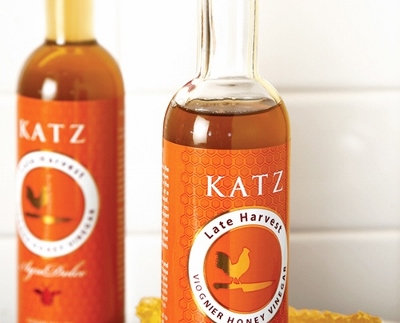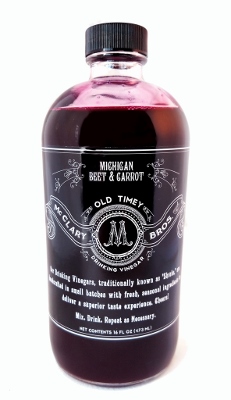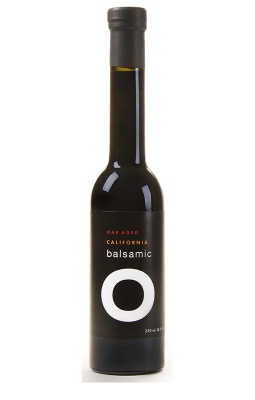Every culture seems to produce a type of vinegar, whether it’s black vinegar of China (aged rice, wheat, millet and sorghum), or Italy’s balsamic vinegar (not really vinegar). There’s plum vinegar, coconut vinegar, and apple cider vinegar, but sadly most vinegars we purchase from our groceries stores are mass-produced in an expedited mechanical method that strips the condiment of its nutrients—even though vinegars are supposed to be slowly crafted.
To make vinegar, alcohol ferments into acetaldehyde, which becomes acetic acid. A slimy and murky substance called the mother (a bacterial culture) grows on the surface and creates the vinegar. Most non-artisan vinegars are made within hours or days. When the vinegar is pasteurized, all of the bacteria (the good stuff) inside the vinegar is no longer living by the time it’s bottled.
Many artisans use the centuries-old Orleans method, which steeps the alcohol and the mother in wooden barrels for a few months to over a year. Holes are chiseled in the barrels so oxygen can invade and ferment the batch. Because it’s considered “craft vinegar,” every batch tastes different—much like craft beer. Just like everything else craft and artisan that’s sprung up lately, artisan vinegar’s becoming a thing. Some chefs use it in lieu of citrus, and home cooks also are discovering how versatile vinegar can be.
Some artisan vinegar makers have been making their small-batch vinegars on idyllic farms for decades. So the next time you consider purchasing ordinary red wine vinegar, consider one (or more) of these handcrafted options.
Back Forty Beer Vinegar

The largest brewery in Gadsden, Alabama, makes beers named Naked Pig Pale Ale, Fence Post Session Ale, and the award-winning Truck Stop Honey Brown Ale, but in December they debuted their Back Forty Beer Vinegar. The vinegar’s fermented with their own malty beer, and can be purchased online for $8 a bottle. Beer vinegar makes sense, as malt vinegar’s a popular staple for fish and chips. Besides the beer and vinegar, Back Forty also produce their own 100% raw honey called Truck Stop Wildflower Honey—it’s the same honey used in the brown ale.
Tavern Vinegar Company

James Beard-nominated chef Jonathon Sawyer of Cleveland’s The Greenhouse Tavern used to make 300 gallons of wine, beer, and malt vinegars in the cellar of his home before he founded Tavern Vinegar Company in 2011. Aligning with the Columbus, Ohio, Middle West Spirits (makers of OYO vodka and whiskey), they craft wonderful flavored vinegars that Sawyer uses in his restaurants and also sells in various places around Cleveland and other markets, including Chicago. Sawyer’s Stout Beer Vinegar takes Colorado brewery’s Tommyknocker stout and ages it 14 months in an oak barrel; the Rose Wine Vinegar’s made with Le Grande Cote, a French rose wine, and ferments for 14 months. There’s also a Riesling vinegar, and an Ohio Witte vinegar, made with Middle West’s sour beer mash. Currently, the vinegars are difficult to find around Cleveland, and most of the vinegars are sold out online (prices range from $9.99-$25), but if you’re lucky, you may be able to snag a bottle.
KATZ Vinegars

Katz’s family ranch make their signature Gravenstein apple cider vinegar from late-ripening apples, and then slowly ages it for a few months in their oak barrels stored in their Californian Suisun Valley vinegar house. The alcohol ages for 2-5 months—in the wintertime it takes longer for the alcohol to convert into vinegar. Because they’re located in California’s fertile wine region, they procure local wines and use them in their Trio vinegar, made with Merlot, Zinfandel and Cabernet. Before they introduced their line of vinegars, the Katzes founded an olive oil business in the ’90s, where they started growing olives on their property. They currently make a Meyer lemon olive oil, a honey vinegar, and a vinegar called AgroDolce (sweet and sour) that is so tasty it won a San Francisco Good Food Award prize this year. KATZ vinegars are popular with chefs, too: Chef Joshua McFadden from Portland, Ore. restaurant Ava Gene’s recently told Bon Appétit that Katz’s vinegars “tastes alive.”
McClary Bros.

Drinking vinegars, aka shrubs, are making a comeback. Shrubs were invented during the 1600s and now have found their way into mixology. Founded in 2012, Ferndale, Mich., McClary Bros. cold-presses organic apple cider vinegar with locally-grown produce such as apples, and cranberries. They have a pineapple and fennel seed variety, made with organic cane sugar, pineapple, and fennel. The mixture’s diluted with water to decrease the acidity. The vinegars are crafted at Forgotten Harvest, a local food rescue. Their vinegars have expanded outside of Michigan to be sold in Chicago, NYC, Philadelphia, Georgia, and many other cities. Besides seemingly used just in cocktails, drinking vinegars can also be used in cooking, and well, taking a swig—literally drinking vinegar.
O Olive Oil and Vinegar

In the mid-‘90s, Californian Greg Hinson started meshing California Mission olives and citruses together to form his brand of all-natural O olive oils. A couple of years later, he started making small batch wine vinegars. Akin to KATZ, O also uses the Orleans method and barrel-ages vinegars such as fig balsamic vinegar (made with local figs), champagne vinegar (using Napa and Sonoma Valley wines), O Cuvee Vinegar (made with lemons), and a pomegranate champagne vinegar (made with California pomegranates). Lead can be found in a lot of European balsamics, so Hinson decided to make his own varietals.
Slide Ridge Honey Vinegar

As the idiom goes, you can catch more flies with honey than with vinegar, but when you’re a purveyor of both, the saying doesn’t apply. Bee colonies are in peril, but Mendon, Utah’s high-desert-based Slide Ridge sees the benefits and uses thousands of their bees to make honey vinegar, and regular honey. Their vinegar’s sweet yet also slightly tart. It can take up to two years to finish a batch of their vinegar, so you know it’s made with a lot of care.
Garin Pirnia, who has a weird, made-up name, is a freelance arts and culture writer and has written for Rolling Stone, Esquire, Mental Floss, and many other publications. Twitter: @gpirnia